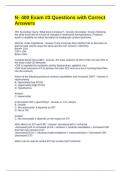Exam (elaborations)
N- 400 Exam #3 Questions with Correct Answers
- Course
- Institution
TBI: Secondary Injury. What does it produce? - Answer-Secondary: Occurs following the initial insult and is a result of changes in intracranial hemodynamics. Produces death or disability via either herniation of inadequate cerebral perfusion. Monroe- Kellie Hypothesis - Answer-If one increases t...
[Show more]



